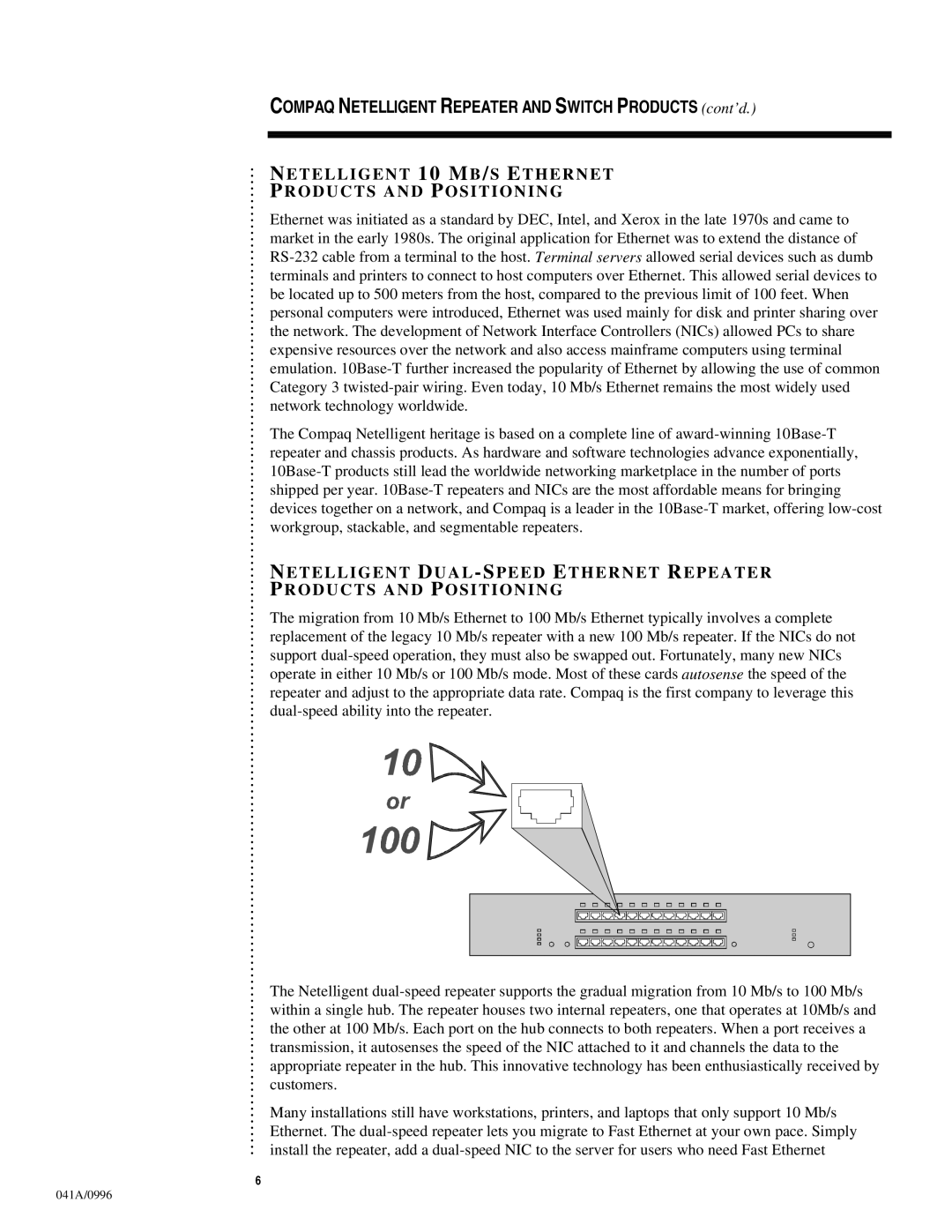COMPAQ NETELLIGENT REPEATER AND SWITCH PRODUCTS (cont’d.)
N E T E L L I G E N T 10 M B / S E T H E R N E T
P R O D U C T S A N D P O S I T I O N I N G
Ethernet was initiated as a standard by DEC, Intel, and Xerox in the late 1970s and came to market in the early 1980s. The original application for Ethernet was to extend the distance of RS-232 cable from a terminal to the host. Terminal servers allowed serial devices such as dumb terminals and printers to connect to host computers over Ethernet. This allowed serial devices to be located up to 500 meters from the host, compared to the previous limit of 100 feet. When personal computers were introduced, Ethernet was used mainly for disk and printer sharing over the network. The development of Network Interface Controllers (NICs) allowed PCs to share expensive resources over the network and also access mainframe computers using terminal emulation. 10Base-T further increased the popularity of Ethernet by allowing the use of common Category 3 twisted-pair wiring. Even today, 10 Mb/s Ethernet remains the most widely used network technology worldwide.
The Compaq Netelligent heritage is based on a complete line of award-winning 10Base-T repeater and chassis products. As hardware and software technologies advance exponentially, 10Base-T products still lead the worldwide networking marketplace in the number of ports shipped per year. 10Base-T repeaters and NICs are the most affordable means for bringing devices together on a network, and Compaq is a leader in the 10Base-T market, offering low-cost workgroup, stackable, and segmentable repeaters.
N E T E L L I G E N T D U A L - S PE E D E T H E R N E T R E PE A T E R P R O D U C T S A N D P O S I T I O N I N G
The migration from 10 Mb/s Ethernet to 100 Mb/s Ethernet typically involves a complete replacement of the legacy 10 Mb/s repeater with a new 100 Mb/s repeater. If the NICs do not support dual-speed operation, they must also be swapped out. Fortunately, many new NICs operate in either 10 Mb/s or 100 Mb/s mode. Most of these cards autosense the speed of the repeater and adjust to the appropriate data rate. Compaq is the first company to leverage this dual-speed ability into the repeater.
The Netelligent dual-speed repeater supports the gradual migration from 10 Mb/s to 100 Mb/s within a single hub. The repeater houses two internal repeaters, one that operates at 10Mb/s and the other at 100 Mb/s. Each port on the hub connects to both repeaters. When a port receives a transmission, it autosenses the speed of the NIC attached to it and channels the data to the appropriate repeater in the hub. This innovative technology has been enthusiastically received by customers.
Many installations still have workstations, printers, and laptops that only support 10 Mb/s Ethernet. The dual-speed repeater lets you migrate to Fast Ethernet at your own pace. Simply install the repeater, add a dual-speed NIC to the server for users who need Fast Ethernet

